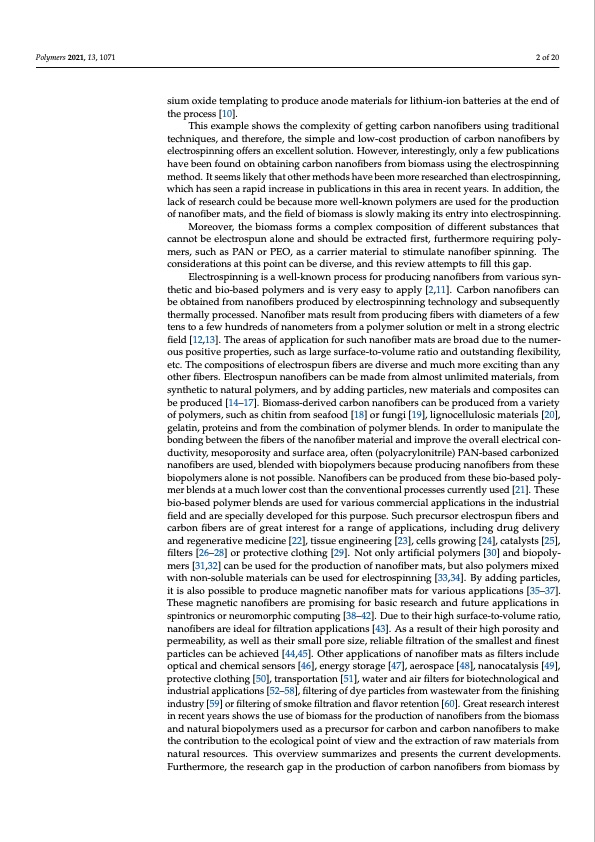
PDF Publication Title:
Text from PDF Page: 002
Polymers 2021, 13, 1071 2 of 20 sium oxide templating to produce anode materials for lithium-ion batteries at the end of the process [10]. This example shows the complexity of getting carbon nanofibers using traditional techniques, and therefore, the simple and low-cost production of carbon nanofibers by electrospinning offers an excellent solution. However, interestingly, only a few publications have been found on obtaining carbon nanofibers from biomass using the electrospinning method. It seems likely that other methods have been more researched than electrospinning, which has seen a rapid increase in publications in this area in recent years. In addition, the lack of research could be because more well-known polymers are used for the production of nanofiber mats, and the field of biomass is slowly making its entry into electrospinning. Moreover, the biomass forms a complex composition of different substances that cannot be electrospun alone and should be extracted first, furthermore requiring poly- mers, such as PAN or PEO, as a carrier material to stimulate nanofiber spinning. The considerations at this point can be diverse, and this review attempts to fill this gap. Electrospinning is a well-known process for producing nanofibers from various syn- thetic and bio-based polymers and is very easy to apply [2,11]. Carbon nanofibers can be obtained from nanofibers produced by electrospinning technology and subsequently thermally processed. Nanofiber mats result from producing fibers with diameters of a few tens to a few hundreds of nanometers from a polymer solution or melt in a strong electric field [12,13]. The areas of application for such nanofiber mats are broad due to the numer- ous positive properties, such as large surface-to-volume ratio and outstanding flexibility, etc. The compositions of electrospun fibers are diverse and much more exciting than any other fibers. Electrospun nanofibers can be made from almost unlimited materials, from synthetic to natural polymers, and by adding particles, new materials and composites can be produced [14–17]. Biomass-derived carbon nanofibers can be produced from a variety of polymers, such as chitin from seafood [18] or fungi [19], lignocellulosic materials [20], gelatin, proteins and from the combination of polymer blends. In order to manipulate the bonding between the fibers of the nanofiber material and improve the overall electrical con- ductivity, mesoporosity and surface area, often (polyacrylonitrile) PAN-based carbonized nanofibers are used, blended with biopolymers because producing nanofibers from these biopolymers alone is not possible. Nanofibers can be produced from these bio-based poly- mer blends at a much lower cost than the conventional processes currently used [21]. These bio-based polymer blends are used for various commercial applications in the industrial field and are specially developed for this purpose. Such precursor electrospun fibers and carbon fibers are of great interest for a range of applications, including drug delivery and regenerative medicine [22], tissue engineering [23], cells growing [24], catalysts [25], filters [26–28] or protective clothing [29]. Not only artificial polymers [30] and biopoly- mers [31,32] can be used for the production of nanofiber mats, but also polymers mixed with non-soluble materials can be used for electrospinning [33,34]. By adding particles, it is also possible to produce magnetic nanofiber mats for various applications [35–37]. These magnetic nanofibers are promising for basic research and future applications in spintronics or neuromorphic computing [38–42]. Due to their high surface-to-volume ratio, nanofibers are ideal for filtration applications [43]. As a result of their high porosity and permeability, as well as their small pore size, reliable filtration of the smallest and finest particles can be achieved [44,45]. Other applications of nanofiber mats as filters include optical and chemical sensors [46], energy storage [47], aerospace [48], nanocatalysis [49], protective clothing [50], transportation [51], water and air filters for biotechnological and industrial applications [52–58], filtering of dye particles from wastewater from the finishing industry [59] or filtering of smoke filtration and flavor retention [60]. Great research interest in recent years shows the use of biomass for the production of nanofibers from the biomass and natural biopolymers used as a precursor for carbon and carbon nanofibers to make the contribution to the ecological point of view and the extraction of raw materials from natural resources. This overview summarizes and presents the current developments. Furthermore, the research gap in the production of carbon nanofibers from biomass byPDF Image | Electrospun Carbon Nanofibers from Biomass and Biomass Blends

PDF Search Title:
Electrospun Carbon Nanofibers from Biomass and Biomass BlendsOriginal File Name Searched:
88145ac687f0c36c7096f236fabe2cba856c.pdfDIY PDF Search: Google It | Yahoo | Bing
Sulfur Deposition on Carbon Nanofibers using Supercritical CO2 Sulfur Deposition on Carbon Nanofibers using Supercritical CO2. Gamma sulfur also known as mother of pearl sulfur and nacreous sulfur... More Info
CO2 Organic Rankine Cycle Experimenter Platform The supercritical CO2 phase change system is both a heat pump and organic rankine cycle which can be used for those purposes and as a supercritical extractor for advanced subcritical and supercritical extraction technology. Uses include producing nanoparticles, precious metal CO2 extraction, lithium battery recycling, and other applications... More Info
| CONTACT TEL: 608-238-6001 Email: greg@infinityturbine.com | RSS | AMP |